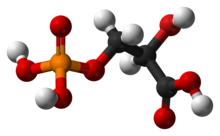This is an old revision of this page, as edited by Addihockey10 (automated) (talk | contribs) at 06:38, 23 January 2012 (Bot : Replacing raster images with vectorized equivalents - File:3-phospho-D-glycerate wpmp.png → File:3-phospho-D-glycerate.svg). The present address (URL) is a permanent link to this revision, which may differ significantly from the current revision.
Revision as of 06:38, 23 January 2012 by Addihockey10 (automated) (talk | contribs) (Bot : Replacing raster images with vectorized equivalents - File:3-phospho-D-glycerate wpmp.png → File:3-phospho-D-glycerate.svg)(diff) ← Previous revision | Latest revision (diff) | Newer revision → (diff)
| |

| |
| Names | |
|---|---|
| IUPAC name (2R)-2-Hydroxy-3-phosphonooxypropanoic acid | |
| Identifiers | |
| CAS Number | |
| 3D model (JSmol) | |
| ChEBI | |
| ChEMBL | |
| ChemSpider | |
| PubChem CID | |
| CompTox Dashboard (EPA) | |
InChI
| |
SMILES
| |
| Properties | |
| Chemical formula | C3H7O7P |
| Molar mass | 186.06 g/mol |
| Except where otherwise noted, data are given for materials in their standard state (at 25 °C , 100 kPa).
| |
3-Phosphoglyceric acid (3PG), or glycerate 3-phosphate (GP), is a biochemically significant 3-carbon molecule that is a metabolic intermediate in both glycolysis and the Calvin cycle. This chemical is often termed PGA when referring to the Calvin cycle. 3-Phosphoglycerate is the resultant of the split of 6-carbon intermediate that is so unstable that it splits instantly. And two 3-phosphoglycerate molecules are produced for each molecule of CO2.
Glycolysis
Template:Biochemical Reaction Compound C00236 at KEGG Pathway Database. Enzyme 2.7.2.3 at KEGG Pathway Database. Compound C00197 at KEGG Pathway Database. Enzyme 5.4.2.1 at KEGG Pathway Database. Compound C00631 at KEGG Pathway Database.
Calvin cycle
In the Calvin cycle, two glycerate 3-phosphate molecules are reduced to form two molecules of glyceraldehyde 3-phosphate (PGAL). This is the first compound formed during the C3 or Calvin cycle. It is a reactive biomolecule that is easily reduced.
Amino acid synthesis
Glycerate 3-phosphate is also a precursor for serine, which, in turn, can create cysteine and glycine through the homocysteine cycle.
See also
| Glycolysis metabolic pathway | |
|---|---|
 ATP
ADP
ATP
ADP

 ATP
ADP
ATP
ADP


+ +
2 × Glyceraldehyde 3-phosphate 2 ×
Glyceraldehyde-3-phosphate  ADP
ATP
ADP
ATP


Phosphopyruvate  ADP
ATP
ADP
ATP
2 × Pyruvate 2 × |
| Glycine receptor modulators | |||||
|---|---|---|---|---|---|
| Receptor (ligands) |
| ||||
| Transporter (blockers) |
| ||||
This article about metabolism is a stub. You can help Misplaced Pages by expanding it. |